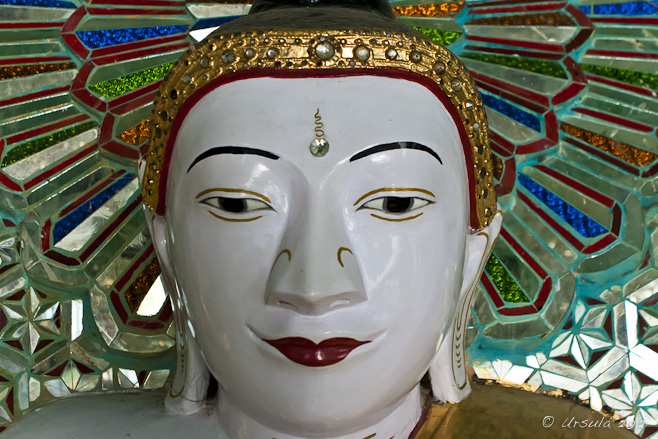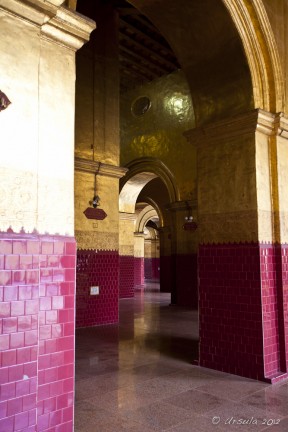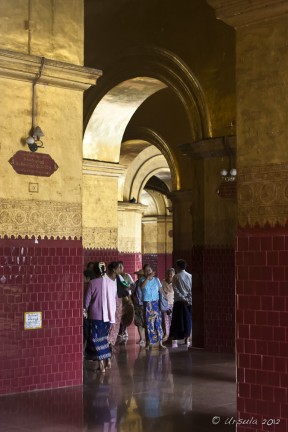
Buddha Head
So shiny, you can almost see yourself! U Min Thonze Cave, Sagaing Hills
Buddhist temples in Myanmar are clearly loved and well cared for. Offerings of gold, flowers, and incense are everywhere, and the walls and floors are so shiny you can see yourself reflected in them: often the product of donated labour.
Mahamuni Temple, Mandalay, and Soon U Ponya Shin Pagoda, in the nearby Sagaing Hills, which I visited one day in September last year with photographer Karl Grobl, guide Mr MM, and a group of other photo enthusiasts, are two cases in point.
When travelling to new places, it is tempting to rush around and see as much as possible, but I was so taken by the shiny floors in the corridors of Mahamuni Temple (Pagoda), that I stood in a corner for a while, just watching people pass over them.

Mahamuni Temple
Shiny Floors and Golden Arches

Reflections
Coming and Goings

Elder Monk
When you stand still in a Burmese temple, people come and talk to you. This elder monk wanted to know what I thought of “the Lady” (Aung San Suu Kyi), and asked me to write my opinions in his notebook.

Woman with Flowers

Woman in Blue
Mahamuni Temple is a major pilgrimage site because of its revered Buddha image, the Maha Myat Muni (or Mahamuni) Buddha. According to legend, the Mahamuni, or “Great Sage”, is one of only five likenesses of the Buddha made during his lifetime. (Archaeologists, however, date the image at around 150 AD, 600 years after the Buddha’s death.) The 4-meter high, 6.5-ton, bronze image is seated on a 1.84-metre high pedestal in a small chamber, and crowned in gold, decorated with diamonds, rubies and sapphires. Every morning at 4:30, monks wash its face and brush its teeth with care.
Gold leaves (like those pounded out at the King Galon Gold Leaf Workshop) are applied to the face and body of the Mahamuni Buddha by male devotees daily. So much leaf has been applied over the generations that the shape of the Buddha has become lumpy and distorted, with the gold as much as 15 cm thick in places.

Maha Myat Muni Buddha Image
Women are not allowed in the chamber, and must pay homage to the image from further away; this was as close as I could get.

Silhouettes in the Corridors

Reflecting, Single File

Mahamuni Grandma
Pilgrims, or the homeless, can find a shiny clean corner of the temple to make their temporary base.

Shoe Woman
The light of the temple is reflected in the eyes and the laughter of the people who work there; these people look after the shoes at the entry.
Late afternoon of the same day, our little group visited the beautiful U Min Thonze Cave and the nearby Soon U Ponya Shin Pagoda, possibly the most important of the many pagodas, temples and monasteries that dot the Sagaing Hills.

Circle of Buddhas
Fourty-five porcelain Buddhas curve around the walkway in the U Min Thonze Cave.

Curving Corridor
U Min Thonze Cave shines: from the light streaming in the arched doorways to the reflective tile floors and the gleaming Buddhas surrounded by mosaics of shimmering glass.

Reverie
Reflective surfaces are everywhere in U Min Thonze Cave, creating a dreamlike atmosphere.

Prayers
Burmese come to the Soon U Ponya Shin Pagoda to pay respects and pray to the Buddha.

Smiling Down
The Buddha at Soon U Ponya Shin Pagoda gleams.

Courtyard
The patterned tiled floors at Soon U Ponya Shin Pagoda reflect in the afternoon sun.

Decorative Grill
A delicate grill screens off part of the temple grounds.

Look Up!
A porcelain lion protects the golden chedi at Soon U Ponyashin Pagoda.

Waiting for Customers
Reflected in the bright floor, a man waits for people to use his telescopes.
Soon U Ponya Shin Pagoda sits at the top of the Nga-pha (Frog) Hill, and, even without the telescopes available, visitors get wonderful views over the Irrawaddy (or Ayeyarwady/Ayeyarwaddy) River and the temple-dotted Sagaing Hills.

The Ava (Innwa) Bridge
View over the temples of the Sagaing Hills and the Irrawaddy River.

Pagodas Large and Small
View from Soon U Ponya Shin Pagoda over Sagaing to the hazy Irrawaddy delta.

Monk on Pilgrimage

Golden Chedi Roofs

Goods for Sale
At every temple, there are goods for sale; a novice and his friend have a browse.

It is easy to feel uplifted in such beautiful places where people’s devotion to their religion is so palpably expressed.
Truly places that allow for reflection.
Mettā!
Pictures: 14September2012




























.png)

